
Controlling the coordination environment of the nanocatalyst surface is a major synthetic challenge to producing electrocatalysts with high activity and high stability. This is particularly important for the methanol oxidation reaction (MOR) in which multiple neighboring metal atoms are needed to prevent CO poisoning.
Using a combination of tunable Pt-island size and a spreading process, we can vary the Pt loading on branched Ru nanoparticles, which leads to tunable proportions of Pt–Pt and Pt–Ru neighboring atoms at the surface. CINT highlight slide here.
Full article here: Tuning the Pt–Ru Atomic Neighbors for Active and Stable Methanol Oxidation Electrocatalysis

Interlayer excitons (IXs) formed at the interface of van der Waals materials possess various novel properties. In parallel development, strain engineering has emerged as an effective means for creating 2D quantum emitters.
Exploring the intersection of these two exciting areas, we use MoS2/WSe2 heterostructure as a model system and demonstrate how strain, defects, and layering can be utilized to create defect-bound IXs capable of bright, robust, and tunable quantum light emission in the technologically important near-infrared spectral range. Our work presents defect-bound IXs as a promising platform for pushing the performance of 2D quantum emitters beyond their current limitations. CINT highlight slide here.
Full article here: Manipulating Interlayer Excitons for Near-Infrared Quantum Light Generation

Redox flow batteries (RFBs) that incorporate solid energy-storing materials are attractive for high-capacity grid-scale energy storage due to their markedly higher theoretical energy densities compared to their fully liquid counterparts. However, this promise of higher energy density comes at the expense of rate capability.
In this work we exploit a ZnO nanorod-decorated Ni foam scaffold to create a high surface area Li metal anode capable of rates up to 10 mA cm−2, a 10× improvement over traditional planar designs. CINT highlight slide here.
Full article here: Fast Cycling of “Anode-less”, Redox-mediated Li-S Flow Batteries

“Giant” or core/thick-shell quantum dots (gQDs) are an important class of solid-state quantum emitter characterized by strongly suppressed blinking and photobleaching under ambient conditions, and reduced nonradiative Auger processes. Together, these qualities provide distinguishing and useful functionality as single- and ensemble-photon sources.
Here, a comprehensive analysis of gQD structural properties “from the inside out” as a function of shell-growth method is reported: successive ionic layer adsorption and reaction (SILAR) and high-temperature continuous injection (HT-CI), or sequential combinations of the two. CINT highlight slide here.
Full article here: From Inside Out: How the Buried Interface, Shell Defects, and Surface Chemistry Conspire to Determine Optical Performance in Nonblinking Giant Quantum Dots

Continued dependence on crude oil and natural gas resources for fossil fuels has caused global atmospheric carbon dioxide (CO2) emissions to increase to record-setting proportions. There is an urgent need for efficient and inexpensive carbon sequestration systems to mitigate large-scale emissions of CO2 from industrial flue gas.
This study by a CINT User Team aims to understand structural aspects that contribute to the stability of CA enzymes critical for their applications in industrial processes, which require the ability to withstand conditions different from those in their native environments. CINT highlight slide here.
Full article here: Carbonic Anhydrase Robustness for Use in Nanoscale CO2 Capture Technologies
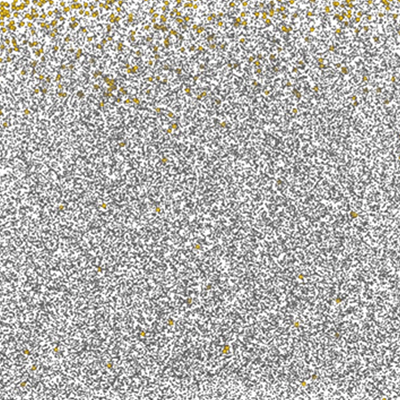
Ion implantation is a key capability for the semiconductor industry. As devices shrink, novel materials enter the manufacturing line, and quantum technologies transition to being more mainstream. Traditional implantation methods fall short in terms of energy, ion species, and positional precision.
Here, we demonstrate 1 keV focused ion beam Au implantation into Si and validate the results via atom probe tomography and show the Au implant depth at 1 keV is 0.8 nm and that identical results for low-energy ion implants can be achieved by either lowering the column voltage or decelerating ions using bias while maintaining a sub-micron beam focus. CINT highlight slide here.
Full article here: Measurement and Simulation of Ultra-Low-Energy Ion–Solid Interaction Dynamics

Chirality is a fundamental molecular property that plays a crucial role in biophysics and drug design. Optical circular dichroism (OCD) is a well-established chiral spectroscopic probe in the UV–visible regime. Chirality is most commonly associated with a localized chiral center. However, some compounds such as helicenes are chiral due to their screwlike global structure. In these highly conjugated systems, some electric and magnetic allowed transitions are distributed across the entire molecule, and OCD thus probes the global molecular chirality.
In an article published in the Journal of the American Chemical Society, a research team including CINT Scientist Sergei Tretiak use the racemization mechanism of helicene as a model to demonstrate the capabilities of OCD and XCD as time-dependent probes for global and local chiralities, respectively. Our simulations demonstrate that XCD provides an excellent spectroscopic probe for the time-dependent local chirality of molecules. CINT highlight slide here.
Full article here: X-ray and Optical Circular Dichroism as Local and Global Ultrafast Chiral Probes of Helicene Racemization

Lithium-ion batteries have enabled the development of electric vehicles but improved performance is necessary for emerging technologies such as electric flight. Solid-state batteries have the potential to provide increased energy and enhanced safety, especially when employed in an “anode-free” architecture in which there is no active anode material. The main challenges of the anode-free architecture are the limited Li+ inventory and the uncontrolled morphological evolution of lithium, which can cause accelerated degradation during charge/discharge.
Recent work with CINT Scientists Matt Schneider and John Watt reveals that localized Li depletion and island formation near the end of stripping play a critical role in limiting the performance of anode-free SSBs. During stripping from anode-free cells with argyrodite SSEs, slightly nonuniform Li thicknesses led to some Li regions being fully stripped before others, locally exposing the electrochemically inactive current collector and leading to current constriction, void growth, and rapid short circuiting upon cycling. This mechanism is unique to anode-free cells since it only occurs when attempting to strip all Li, and it significantly reduces cell stability compared with Li-excess cells. Thus, strategies are needed to improve growth/stripping uniformity and to simultaneously mitigate the formation of isolated islands and current concentrations as the last Li is stripped. CINT highlight slide here.
Full article here: Structural and Electrochemical Evolution of Alloy Interfacial Layers in Anode-free Solid-state Batteries

Quantum light emitters capable of generating single photons with circular polarization and non-classical statistics could enable non-reciprocal single-photon devices and deterministic spin–photon interfaces for quantum networks. To date, the emission of such chiral quantum light relies on the application of intense external magnetic fields, electrical/optical injection of spin-polarized carriers/excitons or coupling with complex photonic metastructures.
In an article published in Nature Materials, we report the creation of free-space chiral quantum light emitters via the nanoindentation of monolayer WSe2/NiPS3 heterostructures at zero external magnetic field. These quantum light emitters emit with a high degree of circular polarization (0.89) and single-photon purity (95%), independent of pump laser polarization. Scanning diamond nitrogen-vacancy microscopy and temperature-dependent magneto-photoluminescence studies reveal that the chiral quantum light emission arises from magnetic proximity interactions between localized excitons in the WSe2 monolayer and the out-of-plane magnetization of defects in the antiferromagnetic order of NiPS3, both of which are co-localized by strain fields associated with the nanoscale indentations. Image credit: Xiangzhi Li. CINT highlight slide here.
Full article here: Proximity-induced Chiral Quantum Light Generation in Strain-engineered WSe2/NiPS3 Heterostructures

Solid-state quantum emitters have emerged as a leading quantum memory for quantum networking applications. However, standard optical characterization techniques are neither efficient nor repeatable at scale.
Here we introduce and demonstrate spectroscopic techniques that enable large-scale, automated characterization of colour centres. These tools will enable the accelerated identification of useful quantum emitters at chip scale, enabling advances in scaling up colour centre platforms for quantum information applications, materials science and device design and characterization. CINT highlight slide here.
Full article here: Large-scale Optical Characterization of Solid-state Quantum Emitters

Fatigue in metals involves gradual failure through incremental propagation of cracks under repetitive mechanical load. In structural applications, fatigue accounts for up to 90% of in-service failure. Prevention of fatigue relies on implementation of large safety factors and inefficient overdesign. In traditional metallurgical design for fatigue resistance, microstructures are developed to either arrest or slow the progression of cracks. Crack growth is assumed to be irreversible. By contrast, in other material classes, there is a compelling alternative based on latent healing mechanisms and damage reversal.
In a new article published in the journal Nature, researchers show that intrinsic microstructural features not only arrest fatigue cracks but can result in crack healing. CINT highlight slide here.
Full article here: Autonomous Healing of Fatigue Cracks in Metals

Semiconductor radiation sensors that directly convert radiation photons to electrical charges offer the best detection quantum efficiency. However, sensors made from classical semiconductor are too expensive to scale up for large scale imaging applications.
In an article published in ACS Energy Letters, CINT Scientist Wanyi Nie and team created a novel hybrid sensor by stacking perovskite semiconductors over graphene channel, which delivers an ultra-high detection sensitivity of 108 uC/Gyair*cm2. Interestingly, the perovskite layer can be fully removed with a room temperature organic solvent bath, which leaves the graphene channel undamaged and greatly reduces the cost to recycle the device. CINT highlight slide here.
Full article here: High-Efficiency X-ray Sensing with Recyclable Perovskite–Graphene Heterostructured Transistors
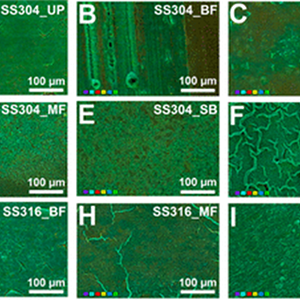
Casting of molten metals is important for nuclear metallurgical foundries, and it is common for thermally robust materials (e.g., carbides, oxides, refractory metals) to be used as molds and crucibles. To prevent their corrosion from molten metals, alloying has been used before as a method of protection, but even alloys are still susceptible to corrosion after repeated exposure. As a result, molds greatly suffer from short lifespans, drastically increasing the costs for replacements and the removal of generated waste.
In a new article published in the journal Applied Materials & Interfaces, researchers examine the role of Er(NO3)3·5H2O and Y(NO3)3·6H2O chemical precursors as well as a commercially available yttria aerosol spray to form oxide coatings onto a low-cost substrate such as SS304 and SS316 in effort to establish a method for creating reusable molds, by relying heavily on solution-based procedures used by others in the area of thin film research. CINT highlight slide here.
Full article here: Chemical Solution Deposition of Rare-Earth Oxide Coatings for Molten Metal Casting

CINT Scientists survey a selection of recent studies that utilize THz emission spectroscopy to uncover basic properties and complex behaviors of emerging materials, including strongly correlated, magnetic, multiferroic, and topological systems.
In a new article published in the journal Light: Science & Applications, a team of scientists, led by Hou-Tong Chen of the Center for Integrated Nanotechnologies at Los Alamos National Laboratory, reviews a selection of recent studies that have utilized terahertz (THz) emission spectroscopy to uncover basic properties and complex dynamical behaviors of emerging materials. These include quantum materials such as superconductors and magnets, as well as low-dimensional materials such as graphene and metal nanostructures. CINT highlight slide here. Full story here.
Full article here: Ultrafast Terahertz Emission from Emerging Symmetry-broken Materials

Generally, alloy design involves a tradeoff between strength and ductility — increase in one involves decrease in the other. By invoking tailored nanostructures that support sequential deformation mechanisms, we show how this can be overcome.
This study in Science Advances highlights the intrinsic plasticity of the NL grains and the significance of the gradient microstructures in achieving high strength and high tensile ductility and thus largely advances our understanding
on the design of strong and ductile structural alloys. CINT highlight slide here.
Full article here: Gradient Nanostructured Steels with Simultaneous Improvements in Strength and Ductility

Clean energy production is the cornerstone of our time. Options for sustainable clean energy include advanced power generation systems that have the potential to drastically reduce the emission of greenhouse gases. These advanced systems are often required to operate under harsh conditions to optimize efficiency, which poses several challenges for the available materials.
In the quest of new materials that can withstand severe irradiation and mechanical extremes for advanced applications (e.g. fission & fusion reactors, space applications, etc.), design, prediction and control of advanced materials beyond current material designs become paramount. In this multi-national collaboration, published in Nature Communications, researchers including CINT Scientists Jonathan Gigax, Yongqiang Wang, and CINT Technologist Kevin Baldwin, design a nanocrystalline refractory high entropy alloy (RHEA) system. CINT highlight slide here.
Full article here: A Quinary WTaCrVHf Nanocrystalline Refractory High-entropy Alloy withholding Extreme Irradiation Environments

Metal additive manufacturing (AM) holds promise as a transformative technological advancement with impact across nearly every industrial sector. The ability to rapidly print parts with internal features, complex geometries, and near-net-shape is advantageous compared to traditional metal fabrication technologies. However, significant development is still required for AM part certification.
Characterization of surfaces for additively manufactured (AM) metals are only valuable to the extent that they can be reliably related to performance properties and compared to other surfaces, including both AM and traditional manufactured surfaces. In this work we aim to define best practices for precise, comparable surface roughness measurements of representative metal AM parts. CINT highlight slide here.
Full article here: Roughness Measurements Across Topographically-varied Additively-manufactured Metal Surfaces

Despite the enormous advances that have been made in topological materials, the study of topological metals has remained almost entirely unexplored.
Here, we directly observe topological phenomena in gapless acoustic crystals and realize a general experimental technique to demonstrate their topology. Specifically, we not only observe robust boundary-localized states in a topological acoustic metal, but also re-interpret a composite operator — mathematically derived from the K-theory of the problem — as a new Hamiltonian whose physical implementation allows us to directly observe a topological spectral flow and measure the topological invariants. CINT highlight slide here.
Full article here: Revealing Topology in Metals using Experimental Protocols Inspired by K-theory

With new experimental method, CINT researchers probe spin structure in 2D materials for first time.
A team of scientists lef by CINT Scientist Andrew Mounce, in collaboration with the University of Innsbruck, describe what they believe to be the first measurement showing direct interaction between electrons spinning in a 2D material and photons coming from microwave radiation. Full story here.
Full article here: Dirac Revivals Drive a Resonance Response in Twisted Bilayer Graphene

The mechanical behavior of molecular crystals has been the subject of much interest, with nanoindentation methods in particular emerging as an important tool for evaluating the plasticity or elasticity of single crystals, calculating fundamental parameters such as hardness and modulus, and establishing the relationship between structure and anisotropic behavior.
Recognizing that cooperative molecular motion over multiple unit cells and large cell volume changes raises mechanical considerations, the nanomechanical properties of CM are the focus of the current study. CINT highlight slide here.
Full article here: Cytosine Monohydrate under Mechanical Stress

The last decade has witnessed a dramatic expansion in the field of defect driven quantum information science, where solid state quantum defects mimicking the coherence properties of trapped ions are exploited for storing, processing and transducing of information as well as sensing physical phenomena beyond classical detection limits.
Here an industry adaptive scalable technique is demonstrated to deterministically create single defects in commercial grade silicon carbide by performing repeated low ion number implantation and in-situ photoluminescence evaluation after each round of implantation. CINT highlight slide here.
Full article here: High-Yield Deterministic Focused Ion Beam Implantation of Quantum Defects Enabled by In Situ Photoluminescence Feedback

The increasing demand for mass data storage and advent of neuromorphic computing technology is attracting a great deal of attention to the exploration of emerging non-volatile memory technologies. Resistive Random Access Memory (RRAM, also referred to as memristor) stands out as one of the most promising candidates as it combines the advantages of good scalability, low power consumption, and fast switching speed.
In this work, we systematically investigate the impact of fabrication process parameters, i.e., film thickness and top electrode deposition rate, on MoS2-based memristors. CINT highlight slide here.
Full article here: Reliability Improvement and Effective Switching Layer Model of Thin-Film MoS2 Memristors
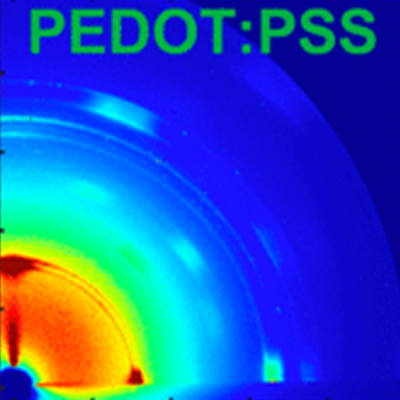
A new approach to simple and scalable fabrication of efficient and stable quasi-2D PSCs that is compatible with the future industrialization of perovskite-based PV technology.
The rise of quasi-2D perovskite structures holds great promise for highly efficient and stable perovskite solar cells (PCSs). As such, fabricating large-area quasi-2D perovskite solar cells (PCSs) with high power conversion remains under active exploration. Here, we introduce a thiophene-based polyelectrolyte as the hole transporting layer (HTL) to facilitate large area quasi-2D PCSs fabrication with high performance. CINT highlight slide here.
Full article here: Thiophene-Based Polyelectrolyte Boosts High-Performance Quasi-2D Perovskite Solar Cells with Ultralow Energy Loss
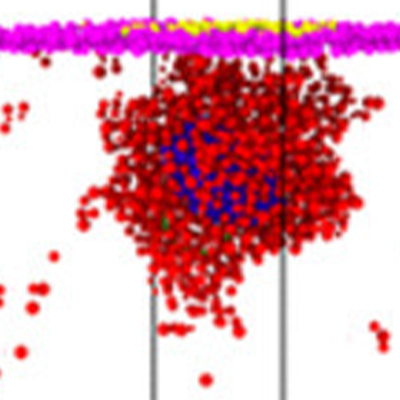
New nanochannel refractory HEA material presents a promising choice as the PFMs with excellent performance and a much longer serving lifetime for future commercial fusion reactors.
In this work, a new nanochannel CrMoTaWV HEA is designed, prepared and tested under the irradiation of high-flux He plasma at high temperature. The results show that the nanochannel HEA film has 20 times higher initial fluence for the formation of fuzz and a remarkable 8.9 times slower fuzz growth rate than those of W during He plasma irradiation. CINT highlight slide here.
Full article here: Enhanced Resistance to Helium Irradiations through Unusual Interaction between High-entropy-alloy and Helium
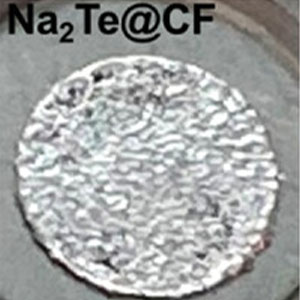
For the first time, a controllable capacity thermal infusion process is demonstrated.
In this study, CINT researchers demonstrate a thin surface layer of electrochemically stable intermetallics (two systems examined, Na2Te and Na2S) thermally deposited onto a commercial 3D copper foam (CF) current collector enables state-of-the-art SMB electrochemical performance. CINT highlight slide here.
Full article here: Intermetallics Based on Sodium Chalcogenides Promote Stable Electrodeposition–Electrodissolution of Sodium Metal Anodes

Unexpected Thermomechanical Behavior of Off-Stoichiometry Epoxy/Amine Materials
Scientists from Los Alamos, Sandia, and Oak Ridge National Laboratories explore whether manipulation of polymer architecture to introduce a large quantity of physically interacting endgroups into thermosets might represent a general strategy for the preparation of dynamic materials with shape memory or self-healing behavior.
Full article here: Unexpected Thermomechanical Behavior of Off-Stoichiometry Epoxy/Amine Materials

Experimentally demonstrated ultrastrong coupling between an individual MIR IST in a GaAs SQW and the resonant mode of photonic nanocavity at room temperature.
Strong and ultrastrong coupling between intersubband transitions in quantum wells and cavity photons have been realized in mid-infrared and terahertz spectral regions. However, most previous works employed a large number of quantum wells on rigid substrates to achieve coupling strengths reaching the strong or ultrastrong coupling regime. In this work, we experimentally demonstrate ultrastrong coupling between the intersubband transition in a single quantum well and the resonant mode of photonic nanocavity at room temperature. CINT highlight slide here.
Full article here: Mid-Infrared Intersubband Cavity Polaritons in Flexible Single Quantum Well
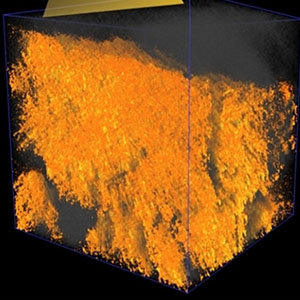
First study to combine synchrotron X-ray imaging and cryogenic-focused ion beam (cryo-FIB) cross-sectional SEM imaging to provide three-dimensional (3D) maps of the electrodeposition behavior of potassium metal on a wettable surface vs. nonwettable surfaces. CINT highlight slide here.
Full article here: Influence of Potassium Metal-Support Interactions on Dendrite Growth
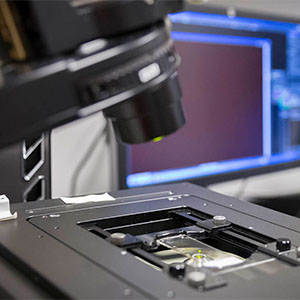
CINT Scientist John Watt uses electron microscopy to detect tiny deposits of gadolinium in the kidneys
Physicians routinely prescribe an infusion containing gadolinium to enhance MRI scans, but there is evidence nanoparticles of the toxic rare earth metal can infiltrate kidney cells, sometimes triggering severe side effects, University of New Mexico researchers have found. CINT highlight slide here.

CINT Collaboration selected for Advanced Materials cover
In the article, Yijie Liu, David Mitlin, John Watt and co-workers report a stable anode-free all-solid-state battery (AF-ASSB) with a sulfide-based solid-electrolyte (argyrodite Li6PS5Cl). The battery is achieved by tuning the wetting of lithium metal on the “empty” copper current-collector. In the cover image, the sprinting antelope represent the lithium cations rapidly diffusing through the solid-state sulfide electrolyte with the blood-red sunset behind them. The still water underneath represents the smooth lithium-metal anode, while the mountains represent the dendrites, which the antelope avoid. CINT highlight slide here.

Evidence of Polaron Formation in Halide Perovskites via Carrier Effective Mass Measurements
This work demonstrates the use of the combination of TRTS and TA to obtain the photoinduced enhancement of m∗ and its time evolution, which not only sheds light on the strength and lifetime of the carrier-phonon interaction in this class of solar cell materials, but can also be applied to many other classes of solid-state systems. CINT highlight slide here.

Sandia News Release — Can clay capture carbon dioxide?
“We would like low-cost energy, without ruining the environment,” said CINT Scientist Susan Rempe, a Sandia bioengineer and senior scientist on the project. “We can live in a way that doesn’t produce as much carbon dioxide, but we can’t control what our neighbors do. Direct-air carbon capture is important for reducing the amount of carbon dioxide in the air and mitigating the carbon dioxide our neighbors release.

Filamentous Fungi Synthesize ZnO Nanoparticles
CINT Scientists demonstrate that biochemical constituents (e.g., organic acids, proteins) secreted by filamentous fungi may be used to sysnthesize zinc oxide.
The repsonse of fungi to metal stress produces biochemical exudates that enable the synthesis of Zno-NPs from various precursor salts. This greeen synthesis method, deemed mycosynthesis, occurs at room temperature and pressure with little chemical input, allowing for a sustainable, scalable, and environmentally benign strategy for NP synthesis. CINT highlight slide here.

Light-Induced Structural Dynamics and Charge Transport in Layered Halide Perovskite Thin Films
CINT Scientists, along with researchers from Los Alamos, Berkeley, and Argonne national labs, and the University of Tennessee discover that light can trigger a strong lattice fluctuation in 2D perovskite materials. The charge transport pathway is tied to the local structural fluctuations that significantly impact the energy conversion process. CINT highlight slide here.